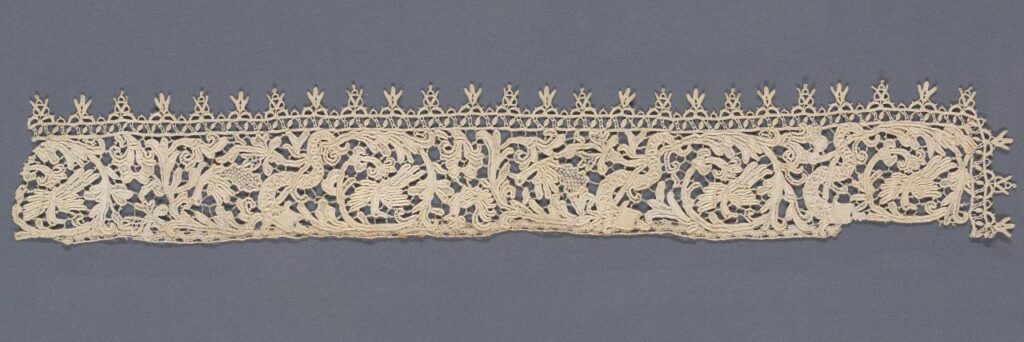
Title: Punto in aria lace
Place: Venice
Date: 16th Century
Medium & technique: Cotton with glass beads
Dimensions: 90 x 560 mm
Themes: Bodies – Inside & Outside
Collection: National Gallery of Victoria, Melbourne
Felton Bequest, 1964. This digital record has been made available on NGV Collection Online through the generous support of Professor AGL Shaw AO Bequest.
This border fragment of Italian lace has distinctive motifs of cockerels, peacocks, phoenixes, and serpents, together with a stylised letter ‘V’. It is part of the substantial collection of lace held in The National Gallery of Victoria, and was made using the so-called punto in aria (lit. stich in air), or needlepoint technique, for which Venice was famous in the sixteenth and seventeenth centuries. Punto in aria lace is entirely free of a base fabric, and is produced by making a series of tiny knots (from a standard repertoire of seven) with a fine thread (usually of cotton) and a regular sewing needle along a drawn design. This design is then detached from the knotted work, leaving the lace behind. It is painstaking work in which a single error cannot be undone, and is noted for the collaborative effort required to produce one piece, as each artisan becomes a specialist in just one of the given knots. Such lace was often produced in Venetian convents but also by laywomen, especially after Dogaressa Morosina Morosini (1545-1614) established a lace school at the end of the sixteenth century in order to ensure a regular supply.
Both bobbin and reticella lace were also produced in Venice, but these techniques tended to be grid-like and repetitive in their final design. The exquisite capacity for free designs of punto in aria lace made it an esteemed item of consumption amongst the elite of Europe. Heraldic devices as well as beautiful shapes could be readily created. It was worn by nobles and monarchs throughout Europe, including Elizabeth I and Charles I of England, and reputedly by Louis XIV of France upon his coronation.
It has been suggested that this fragment was made for the Visconti family of Milan. Presumably this suggestion relates to the letter ‘V’ whose repetition forms a decorative edging, and the fact that the Visconti feature a viper, or biscione, in their heraldry. This provenance is, however, unlikely. The male line of the Visconti was extinguished in 1447, and their emblem was then subsumed into the Sforza family armorial. What is depicted here is not readily identifiable as either a Visconti or a Sforza viper which was always shown in the act of consuming a human figure – sometimes a child, or a Moor, or an Ottoman Turk. Moreover cockerels, peacocks, and phoenixes do not feature in any emblems associated with these families.
There is obviously need for further research about the origins and symbolism and of this lace. But a combination of cockerels and snakes features in the coat of arms of the island of Murano in the Venetian lagoon. The cockerel consuming a snake in this armorial represents the triumph of vigilance (the cockerel) over cunning (the snake). Murano is an island also famous for its production of conterie or seed beads of glass, traded throughout the known world by Venetian merchants, used in this border lace as eyes in the various animals.
If this lace were to have been produced on Murano, it would most likely have been produced in a convent, as a group effort. In the sixteenth century Murano had several convents but one in particular was noted for its exclusively noble occupants and the beautiful artwork and accoutrements they commissioned – the Augustinian convent of Santa Maria degli Angeli.
One noble family prominently associated with this convent in the fifteenth and sixteenth centuries was the Venier. Could the repeated letter ‘V’ in the edging indicate that it was produced for a member of this family? The repeated letter ‘V’s are also overlain with another shape with an unusual bulbous top. Could this be a stylized doge’s ‘corno’? And might this then indicate that this piece was associated in some way with the most prominent Venier of this century, Doge Sebastiano Venier who, as general, had nobly acquitted himself against the Turks at the battle of Lepanto? Sebastiano’s father Moisè was buried in the convent’s church and Sebastiano too requested to be buried there. Because of his status in the city’s history, he was eventually reinterred in the Basilica of San Giovanni e Paolo, but a memorial plaque to his original site of burial is still extant in Santa Maria degli Angeli. Could this border have been produced by the nuns of the convent for the funeral of Doge Sebastiano Venier? In which case not only the signature animals of Murano – the cockerel and snake – but also the phoenix as the symbol of rebirth and eternal life, and the peacock as the symbol of fame and also of eternal life, would be congruent. This is of course conjectural, but it does offer a more consistent and suggestive reading of this exquisite object than that currently provided.
Dr. Catherine Kovesi, Senior Lecturer in History, University of Melbourne